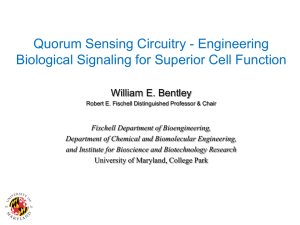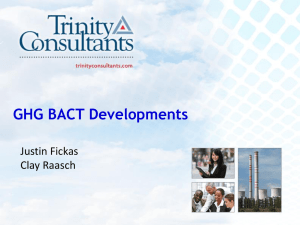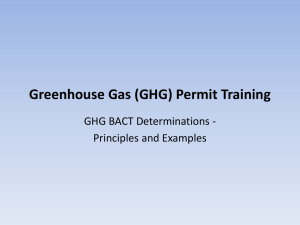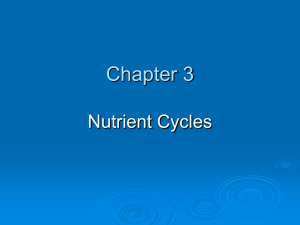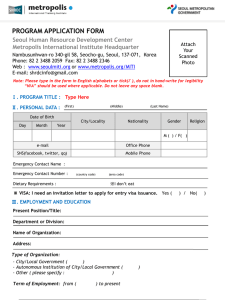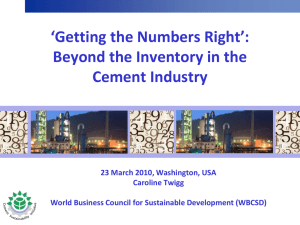GHG BACT Examples
advertisement
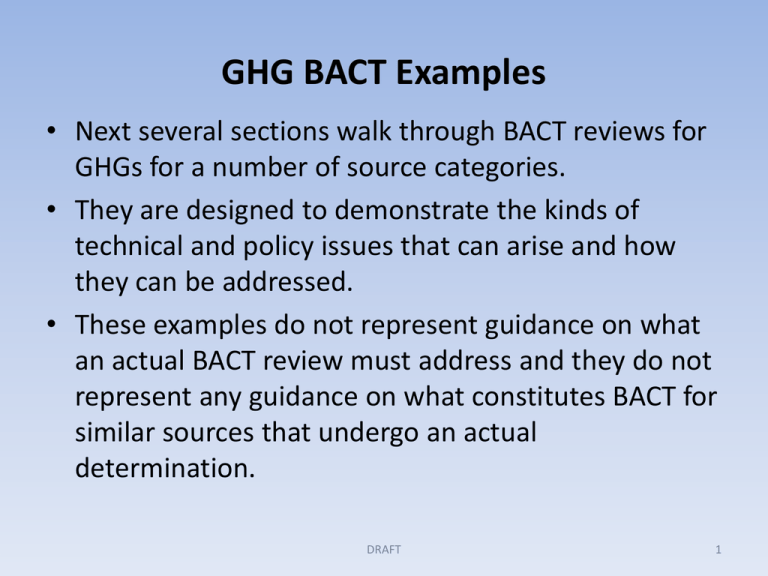
GHG BACT Examples • Next several sections walk through BACT reviews for GHGs for a number of source categories. • They are designed to demonstrate the kinds of technical and policy issues that can arise and how they can be addressed. • These examples do not represent guidance on what an actual BACT review must address and they do not represent any guidance on what constitutes BACT for similar sources that undergo an actual determination. DRAFT 1 GHG BACT Example: Municipal Solid Waste Landfill BACT Example: MSW Landfill Project: New, large municipal solid waste landfill. Step 1: Identifying all available controls •For capture of the landfill gas, the application proposes use of an active capture system that will be in compliance with the NSPS that applies to the NMOC emissions •For control, the following NSPS compliant options are examined: – Flaring of the gas – Using gas in on-site internal combustion engines to generate electricity for sale – Treating gas for delivery to a natural gas pipeline DRAFT 3 BACT Example: MSW Landfill (cont’d) Step 1 (cont’d) • The permitting authority asked the applicant to review two additional control measures: – Collect and control landfill gas earlier in the life of the landfill than is specified in the NSPS – A gas turbine to generate power rather than internal combustion engines • At this stage, there are two options for gas capture : – NSPS compliant active capture system – That system, with earlier initiation of gas collection DRAFT 4 BACT Example: MSW Landfill (cont’d) Step 1 (cont’d) • There are four options for the control of the landfill gas: – – – – Flaring, Fueling engines, Fueling a gas turbine, and Treatment and routing of the gas to a pipeline DRAFT 5 BACT Example: MSW Landfill (cont’d) Step 2: Elimination of technically infeasible options • Applicant demonstrated that the volume of gas would be inadequate to fuel a commercially available gas turbine • Permitting authority reviewed the record • Accepted elimination of that option from further consideration DRAFT 6 BACT Example: MSW Landfill (cont’d) Step 3: Evaluation and ranking of controls by their effectiveness • Applicant used CO2e emissions over the life of the landfill, as the effectiveness indicator • Considered combinations of capture systems and controls for overall effectiveness • Early capture of gas and conversion of the gas to pipeline quality for export is the most effective combination, from a PSD perspective: – Maximum amount of gas would be captured – Most of the gas would not be combusted on site • Flaring and the use of engines are similar in their control – Reducing methane emissions significantly – Generating relatively small on-site CO2 emissions DRAFT 7 BACT Example: MSW Landfill (cont’d) Step 4: Evaluating the most effective controls • Analysis of the cost effectiveness, expressed as $/ton of CO2e reduced over the life of the landfill. • Applicant found conversion of gas to pipeline quality was not cost effective. Would more than double the overall cost of the project since the landfill was far from an existing pipeline. • NSPS compliant control system with early collection was cost effective for either the flare or the engines case. • The flare was more cost effective because revenue from the sale of power from use of engines would not offset the added cost of the engines and a power transmission line. DRAFT 8 BACT Example: MSW Landfill (cont’d) Step 4 (cont’d) Any significant energy and environmental impacts to be considered: • The application noted a positive environmental impact from the use of a flare because NOX emissions for a flare would be lower than those for the engines. • Public comment identified positive energy and environmental offsite impacts arising from using landfill gas to generate electricity which displaces offsite energy generation and associated emissions. • Permitting authority determined that this benefit outweighed the lower NOx emissions and better cost effectiveness of a flare. DRAFT 9 BACT Example: MSW Landfill (cont’d) Step 5: Selecting BACT Permitting authority determined BACT to be: • NSPS compliant active collection system with early installation/operation • Landfill gas routed to engines and used to generate electricity DRAFT 10 BACT Example: MSW Landfill(cont’d) Step 5 (cont’d) Permit conditions are: • CO2e limit on engine emissions, expressed in lbs per kWh, to be demonstrated in a stack test annually. • Compliance with the landfill NSPS design, operating and recordkeeping requirements • Earlier trigger for gas capture and use • Requirement to operate engines under a written O&M plan to assure combustion efficiency DRAFT 11 GHG BACT Example: Natural Gas Fired Boiler BACT Example: Gas Boiler Project Scope: • Existing major source • New 250 MMBtu/hour natural gas-fired boiler DRAFT 13 BACT Example: Gas Boiler (cont’d) Step 1: Identifying all available controls Permit application lists the following four controls: • Oxygen Trim Control: – Inlet air flow adjusted for optimal thermal efficiency • Economizer: – Increases thermal efficiency by preheating feedwater • Blowdown Heat Recovery: – A heat exchanger transfers some of the heat in the blowdown water to feedwater for deaeration or preheating – Increases the boiler’s thermal efficiency DRAFT 14 BACT Example: Gas Boiler (cont’d) Step 1 (cont’d) • Condensate Recovery: – When hot condensate is returned to the boiler as feedwater, the thermal efficiency increases Permitting Authority asks for inclusion of air preheater DRAFT 15 BACT Example: Gas Boiler (cont’d) Step 1 (cont’d) • Public comment asks for consideration of a combined cycle natural gas-fired turbine • Applicatant explains that a boiler is necessary for business purposes: – Providing process steam (and not electricity) and – Varying steam demand • Permitting authority rejects a combined cycle natural gas-fired turbine for consideration on grounds it would “redefine the source.” DRAFT 16 BACT Example: Gas Boiler (cont’d) Step 2: Eliminating technically infeasible options • Permitting authority determines that the six controls are technically feasible; demonstrated or available and applicable to this type of source Step 3: Evaluation and ranking of controls by their effectiveness • Applicant ranked control measures for the boiler based on their impact on the thermal efficiency of the boiler (Could also be based on emissions per unit of steam produced) DRAFT 17 BACT Example: Gas Boiler (cont’d) Step 3 (cont’d) The permit applicant completed the control effectiveness analysis and found: • Most effective single measure is oxygen trim control • Air preheater is no more effective than an economizer in recovering exhaust heat • The most effective combination of measures is: oxygen trim control, an economizer, condensate recovery, and blowdown heat recovery . DRAFT 18 BACT Example: Gas Boiler (cont’d) Step 4: Evaluating the most effective controls • Permit applicant completed an analysis of the cost effectiveness: – Considered both measures and combinations of measures, – Expressed as $/ton of CO2e reduced – Given the size and layout of the facility, boiler blowdown heat recovery was not cost effective • Next most effective combination of measures was: – the use of oxygen trim control – an economizer – condensate recovery DRAFT 19 BACT Example: Gas Boiler (cont’d) Step 4: (cont’d) • Any significant energy and environmental impacts to be considered in this step. • Application identifies recovery and reuse of condensate: – Reduces the use of feedwater treatment chemicals – Reduces generation of related waste – Reduces the amount of water going to wastewater treatment at the site DRAFT 20 BACT Example: Gas Boiler (cont’d) Step 5: Selecting BACT Permitting authority determined, and the record showed, that BACT was the combination of: • • • Oxygen trim control, An economizer, and Condensate recovery DRAFT 21 BACT Example: Gas Boiler (cont’d) Step 5: (cont’d) Permit conditions included: • • • • • • Emission limit: lbs of CO2e per pound of steam produced, 30-day rolling monthly average CO2e emissions determined from natural gas use and standard emission factors Steam production determined from a gauge Installation of boiler as described in the application, as a design standard Preventive maintenance program for the air to fuel ratio controller Periodic calibration of gas meter and steam flow analyzer DRAFT 22 GHG BACT Example: Petroleum Refinery Hydrogen Plant Addition BACT Example: Petroleum Refinery Hydrogen Plant Project Scope: • Expand the hydrogen production and hydrotreating capacity of an existing major source refinery • For simplicity, analysis addresses the GHG BACT for the new hydrogen plant that is being added in the context of a larger project DRAFT 24 BACT Example: Petroleum Refinery Hydrogen Plant (cont’d) DRAFT 25 BACT Example: Petroleum Refinery Hydrogen Plant (cont’d) Project Scope (cont’d): • Proposed project producing hydrogen via the steam methane reforming (SMR) process. In SMR, methane and steam are reacted via a catalyst to produce hydrogen and CO. The reaction is endothermic and the necessary heat is provided in a gas-fired reformer furnace. The CO reacts further with the steam to generate hydrogen and CO2. CH4 + H2O = CO + 3H2 CO + H2O = CO2 + H2 • The hydrogen is then separated from the CO2 and other impurities. The application shows that the purification is done using a Pressure Swing Adsorption Unit. The permit applicant proposes to use the off gas from that step (containing some hydrogen, CO2, and other gases) as part of the fuel for the reformer furnace. DRAFT 26 BACT Example: Petroleum Refinery Hydrogen Plant (cont’d) Step 1: Identifying all available controls • Permit application lists the following control options for GHG emissions: – Furnace Air/Fuel Control – An oxygen sensor in the furnace exhaust is to be used to control the air and fuel ratio for optimal efficiency – Waste Heat Recovery – The overall thermal efficiency is to be optimized through the recovery of heat from both the furnace exhaust and the process streams to preheat the furnace combustion air, to preheat the feed to the furnace and to produce steam for use in the process and elsewhere in the refinery. – CO2 Capture and Storage – Capture and compression, transport, and geologic storage of the CO2. (Some refineries isolate hydrogen reformer CO2 for sale but that is not a part of this example project.) • The permitting authority did not require the applicant to consider any additional control options beyond those in the application, and none were suggested in public comments. DRAFT 27 BACT Example: Petroleum Refinery Hydrogen Plant (cont’d) Step 2: Eliminating the technically infeasible options • In this example, the permitting record shows that all three controls are technically feasible because there is no evidence that any of these options are not demonstrated or available to this type of source. DRAFT 28 BACT Example: Petroleum Refinery Hydrogen Plant (cont’d) Step 3: Evaluation and ranking of controls by their effectiveness • The applicant ranked control measures for the hydrogen plant based on the CO2e emissions per unit of hydrogen produced. • An output-based indicator is a good way to capture the overall effect of multiple energy efficiency measures used in the design of a complex process such as this. • The permit applicant effectiveness analysis included benchmarking data on the energy efficiency and GHG emissions of recently installed hydrogen plants. • Benchmarking data showed that this hydrogen plant would be a lower emitter (on an output basis) than similar new plants, and the permitting authority concurred in that determination. • The applicant determined that the most effective control combination was one in which all three options (furnace control, heat recovery and CCS) were included. DRAFT 29 BACT Example: Petroleum Refinery Hydrogen Plant (cont’d) Step 4: Evaluating the most effective controls • Applicant analysis of the cost effectiveness of measures and combinations of measures was expressed as $/ton of CO2e reduced. The applicant also determined the incremental cost effectiveness. • The information supplied by the applicant demonstrated that the transport and sequestration of CO2 would not be cost effective because the nearest prospective location for sequestration was more than 500 miles away and there was not an existing pipeline suitable for CO2 transport between the refinery and the sequestration location. DRAFT 30 BACT Example: Petroleum Refinery Hydrogen Plant (cont’d) Step 4 (cont’d) • The cost of transport was significant in comparison to the amount of CO2 to be sequestered and the cost of the project overall. • In responding to public comments on the issue, the permitting authority noted that in circumstances in which a refinery was located near an oil field that used CO2 injection for enhanced recovery, the cost calculations for transport and sequestration would likely be in a range that would not exclude CCS. • Other significant energy and environmental impacts are also considered in this step. In this case, none were presented in the application, and the only significant public comment on the issue was addressed by the permitting authority as noted above. DRAFT 31 BACT Example: Petroleum Refinery Hydrogen Plant (cont’d) Step 5: Selecting BACT • With the analysis and record complete, the permitting authority determined that BACT was a combination of furnace combustion control and integrated waste heat recovery. DRAFT 32 BACT Example: Petroleum Refinery Hydrogen Plant (cont’d) Step 5 (cont’d) BACT Permit Limits: • Emission limit in pounds of CO2e emitted per pound of hydrogen produced, averaged over rolling 30 day periods. • CO2e emissions would be determined by metering natural gas sent to the hydrogen plant. There may need to be an adjustment for excess fuel gas sent to other parts of the refinery on a periodic basis. A separate meter and fuel analysis would be needed to get that credit. • Hydrogen production would be metered. • The plant would need to be installed as described in the application. • There would need to be a program for calibration and maintenance of meters and the oxygen trim system. DRAFT 33 GHG BACT Example: Coal-Fired Electric Generating Unit BACT Example: Coal EGU Project: New greenfield sub-bituminous pulverized coal-fired boiler and steam turbine electricity generating facility. DRAFT 35 Coal EGU – Boiler and Steam Turbine superheated steam Multi-stage Steam Turbine Generator low pressure steam reheated steam steam Steam Drum hot boiler feedwater extracted steam Condenser Boiler Wall Watertubes Reheater Feedwater Heater Superheater Coal Silo Economizer Burners cooling water Cooling Tower boiler feedwater Air Pollutant Emissions Controls flue gas coal fly ash Furnace Chamber Induced Draft Fan Air Heater ambient air coal bottom ash Forced Draft Fan heated combustion air Coal Pulverizer DRAFT 36 BACT Example: Coal EGU (cont’d) Step 1: Identifying all available controls Applicant’s BACT analysis had two elements: – Efficiency measures, including the design of the boiler and turbine: • Super critical boiler and turbine design • Coal drying • Optimized combustion with continuous control – CO2 control through CCS. State requests that the BACT analysis also include: – Ultra-super critical design – Integrated Gasification Combined Cycle (IGCC) – Motor efficiency improvements (to increase net output of electricity and thereby fuel use) DRAFT 37 IGCC DRAFT 38 IGCC with Pre-Combustion CO2 Capture Step 1 (cont’d) • Pre-combustion capture of CO2 is an option with coal gasification. In the gasifier, the coal decomposes in the presence of oxygen to syngas, a mixture of H2 and carbon monoxide (CO), along with minor other constituents. • To enable pre-combustion capture, the syngas is further processed to convert CO into CO2 while producing additional H2. A solvent absorption system can then be used to separate the CO2 from the H2. DRAFT 39 IGCC with Pre-Combustion CO2 Capture (continued) Step 1 (cont’d) • After CO2 removal, the H2 can be used as a fuel in the combustion turbine. • Pre-combustion CO2 capture is less expensive than postcombustion capture. The advantages of this type of system are the higher CO2 concentration and the lower volume of syngas to be handled, which result in smaller equipment sizes and lower capital costs. DRAFT 40 BACT Example: Coal EGU (cont’d) • Public comment calls for use of natural gas instead of coal. While this happened after the BACT determination and draft permit were out for comment, it relates to the control measures considered in Step 1 of the analysis. • The permitting agency determines this is outside the scope of BACT, representing a change in basic design and business purpose. DRAFT 41 BACT Example: Coal EGU (cont’d) Step 2: Elimination of technically infeasible options • All options are considered by the permitting authority to be available and technically feasible: – – – – – – Ultra-supercritical boiler and turbine design Integrated Gasification Combined Cycle Coal drying Combustion control Variable speed motors CCS DRAFT 42 BACT Example: Coal EGU (cont’d) Step 3: Evaluation and ranking of controls by their effectiveness • Applicant proposes to rank measures based on emissions per unit of fuel used • State requires that options be ranked by CO2 emissions on a “net” output basis. • Most effective combination is either ultra-supercritial with CCS or IGCC with CCS. Coal drying and efficient motors included in both instances. DRAFT 43 BACT Example: Coal EGU (cont’d) Step 4: Evaluating the most effective controls • CCS dismissed for both designs based on excessive costs, siting issues, and parasitic electricity load • In the absence of CCS, IGCC shown to not superior to ultrasupercritical design • Ultra-supercritical chosen as BACT: cost-effective, no adverse collateral impacts • All energy efficiency measure also required • Permitting agency documents conclusion with supporting documentation for the record DRAFT 44 BACT Example: Coal EGU (cont’d) Step 5: Selecting BACT BACT is determined to be: • A ultra-supercritical boiler design w/ high efficiency steam turbine, • Control of boiler air fuel ratio, • Coal drier using low grade/waste heat • High efficiency variable speed motors for electric drives DRAFT 45 BACT Example: Coal EGU (cont’d) Step 5 (cont’d) Enforceable permit conditions are: • Annual limit in tons of CO2 per net MWh; rolling 12 month totals • O&M plan addressing combustion controls, steam turbine efficiency and electrical motors DRAFT 46 GHG BACT Example: Cement Plant BACT Example: Cement Plant Project Scope: • A new cement kiln is proposed. The product is finished cement for local markets. Cement is produced from raw materials such as limestone, chalk, shale, clay, and sands which are quarried, crushed, ground, and blended to the correct chemical composition. • The raw material is fed into a large rotary kiln (cylindrical furnace) which rotates while the contents are heated to extremely high temperatures. The high temperature causes the raw material to react and form a hard nodular material called “clinker”. Clinker is cooled and ground with gypsum and other additives to produce portland cement. • CO2 is emitted due to both the decomposition of the limestone and the combustion of fuel in the kiln. DRAFT 48 BACT Example: Cement Plant (cont’d) DRAFT 49 BACT Example: Cement Plant (cont’d) Step 1: Identify all available controls • This BACT analysis has four elements: process technology/energy efficiency, fuel choice, product specification and CO2 removal and storage. Process Technology/Energy Efficiency • Applicant proposes to use a preheater/precalciner design, which is more efficient that older designs that have less heat recovery. DRAFT 50 BACT Example: Cement Plant (cont’d) Process Technology/Energy Efficiency (Cont’d) • Applicant presents the following features of the PH/PC design that improve thermal efficiency and reduce emissions of CO2 related to on-site fuel use. – Modern cement manufacturing facilities incorporate multi-stage preheaters prior to the kiln. A five stage preheater is proposed. – Grate coolers are used to cool the clinker. The grate cooler is integral to heat recovery from the clinker and higher thermal efficiency. A reciprocating grate cooler, which is the design with the greatest fuel use benefit, is proposed. – Computerized/automated control system is proposed to optimized fuel combustion conditions. DRAFT 51 BACT Example: Cement Plant (cont’d) Process Technology/Energy Efficiency (Cont’d) – Kiln seals reduce heat loss. The applicant presents information on the effectiveness and longevity of the kiln seals and proposes a maintenance plan for the kiln seals. – Significant heat loss can occur through the kiln shell and proper insulation keeps these losses to a minimum. The applicant presents the alternative refractory that were considered and demonstrates that the most effective was chosen. • The applicant presents data on the energy use per ton of clinker that has been achieved at recently built kilns as a demonstration that the proposed design constitutes BACT for the thermal efficiency aspect of the new kiln. DRAFT 52 BACT Example: Cement Plant (cont’d) Step 1 (cont’d) Fuel Choice • Applicant proposes to use a combination of coal as the primary fuel and wood wastes (when they are available). • Applicant presents data showing that other solid fuels (tires, waste plastics) do not represent a reduction in CO2 emissions at the kiln. • Permitting Authority agrees. DRAFT 53 BACT Example: Cement Plant (cont’d) Step 1 (cont’d) Product Composition • Applicant does not address product composition in the initial application. • To the extent that one can make a finished product, meeting all of its quality requirements with less clinker, the finished product will be less energy intensive and the emissions of CO2 per unit of product will be reduced. Fly ash from coal combustion can be used in a blended cement. However, the use of fly ash may be limited by product quality requirements and fly ash characteristics. DRAFT 54 BACT Example: Cement Plant (cont’d) Step 1 (cont’d) Product Composition • With that in mind, the agency asks the applicant to consider maximum use of fly ash and other additives as blending materials with consideration of the markets to be served. • Applicant presents information on product specifications in the anticipated markets and indicates that up to 5% fly ash from a nearby coal fired utility could be used in some of their product. A CO2 reduction in terms of CO2 per ton of finished cement due to fly ash use is noted. • This alternative is accepted for further review by the permitting authority. DRAFT 55 BACT Example: Cement Plant (cont’d) Step 1 (cont’d) CO2 Capture/Removal and Storage • Applicant presents information on two means of capture and control: conventional Carbon Capture and Storage and the Calera process. • The Calera process uses a wet scrubber to capture CO2 emissions and chemically convert the captured CO2 to carbonates. Carbonate minerals can then be precipitated from the solution, dried, and used to make blended cement or other building materials. DRAFT 56 BACT Example: Cement Plant (cont’d) Step 2: Eliminating technically infeasible options Fuel Choice • During the public comment, use of natural gas in place of coal is raised. • The applicant points out that it is technically feasible to use gas, with an increase in NOx emissions. However, there is no natural gas supply infrastructure with sufficient capacity in the area. • The costs of getting gas delivered and used are addressed and the applicant presents data showing it will not be cost effective. The permitting authority agrees. DRAFT 57 BACT Example: Cement Plant (cont’d) Step 2 (cont’d) Product Composition • Applicant present data showing that use of more fly ash will not allow them to meet product specifications. • Applicant also presents data on the availability of other product blend materials showing that they can adversely affect product quality and there is no identifiable long term supply. • As a result, the assessment is limited to 5% fly ash in 80% of the product, averaged over 12 months. DRAFT 58 BACT Example: Cement Plant (cont’d) Step 2 (cont’d) CCS • The applicant points out that the Calera process is still under development and not commercially available. The applicant also notes that once it is commercial, issues of markets for the by-product and cost would need to be considered. Lastly the applicant points out that the nature of the Calera process and its products would be a change to their fundamental business purpose. • The applicant notes that the capture and purification of CO2 from a cement kiln is understudy and is not commercially available. • The application indicates that CCS is not commercially available or technically feasible and should be dismissed. The agency concurs. DRAFT 59 BACT Example: Cement Plant (cont’d) Step 3: Evaluating and ranking controls for their effectiveness • The measures were ranked based on CO2 emitted per ton of clinker. (Cement kiln performance benchmarking data is presented on this basis.) • At the agency’s request the ranking also was done based on CO2 emitted per ton of finished cement. This change allowed the analysis to capture the impact that fly ash addition could have on emissions. DRAFT 60 BACT Example: Cement Plant (cont’d) Step 4: Evaluating the most effective controls The use of the high efficiency kiln design and the use of fly ash in the product were both found to be cost effective on the basis of dollars per ton of CO2 eliminated. – Other environmental issues were identified with efforts to commit to the use of alternative waste as fuels. However, alternative fuels had not shown a clear CO2 emissions reduction potential for the site emissions. DRAFT 61 BACT Example: Cement Plant (cont’d) Step 5: Selecting BACT • In this example, BACT is the use of the PH/PC design with all of the efficiency improvements proposed by the applicant. • Additionally, the applicant is to use 5% fly ash in the cement blend whenever the product specification allows for its use. DRAFT 62 BACT Example: Cement Plant (cont’d) Step 5 (continued) Enforceable Permit Conditions • The kiln is to meet a 365 day rolling annual average limit on tons of CO2 emitted per ton of clinker produced. • CO2 determined with a CEMS. • A maintenance plan for insulation and kiln seal is also required. • An O&M for the process optimization controls, including instrument calibration and maintenance is required. • Records of fly ash use in product required. If annual average fly ash addition is less than 5%, the company needs to justify its lower use based on product quality concerns or client restrictions. DRAFT 63 GHG BACT Example: Natural Gas Compressor Station Expansion BACT Example: Natural Gas Compressor Station Project : Applicant is proposing to install two reciprocating compressors with reciprocating gas-fired engine drivers at an existing natural gas pipeline compressor station. DRAFT 65 BACT Example: Natural Gas Compressor Station (cont’d) Step 1: Identifying all available controls • Applicant includes the following elements in the initial BACT determination: – Air/fuel ratio controllers to minimize methane emissions from the reciprocating engines – Periodic inspection and maintenance of the compressor rod packing to determine when to replace packing – Use of low-bleed gas-driven pneumatic controllers to reduce methane venting – Installation of a new flare and periodic inspection and maintenance of that flare, which will handle natural gas emissions during upsets and malfunctions DRAFT 66 BACT Example: Natural Gas Compressor Station (cont’d) Step 1 (cont’d) • Permitting authority asks that the applicant consider a gas turbine with a centrifugal compressor in place of the reciprocating engines because the site already has a turbine and a turbine will have lower GHG emissions. • Permitting authority suggests that pneumatic controllers could be driven by instrument air instead of natural gas with lower emissions. • During the public comment period, someone asks that electric drive be considered. DRAFT 67 BACT Example: Natural Gas Compressor Station (cont’d) Step 1 (cont’d) • Applicant plans to use the existing condensate tanks. Permitting authority determines this is a change in the method of operation of those tanks and requires that they go through BACT. • The permitting authority asks that the BACT review address the installation of vapor recovery on the existing tanks even though they are not going to be physically modified. Vapor recovery could also be applied to compressor rod packing. DRAFT 68 BACT Example: Natural Gas Compressor Station (cont’d) Step 1 (cont’d) • At this point there are eight control measures under consideration: – – – – – – – – Air/fuel ratio controller on the reciprocating engines Use of a turbine instead of the reciprocating engines Periodic inspection and maintenance of compressor rod packing Use of low-bleed gas-driven pneumatic controllers Use of instrument air to drive pneumatic controllers Use of a high efficiency flare for upset emissions control Vapor recovery unit for condensate tanks and rod packing Use of electrical drive instead of a gas based drive DRAFT 69 BACT Example: Natural Gas Compressor Station (cont’d) Step 2: Eliminating technically infeasible options • The applicant provides evidence that electrical service does not exist in the vicinity of the compressor station and that the use of electrical drives, vapor recovery unit, and air compressors (for instrument air) using offsite power generation is not feasible. Further onsite power generation will not reduce GHG emissions. • The applicant indicates that the site needs enhanced ability to handle load swings and a turbine is not suitable for that purpose. • Permitting authority agrees that electric drive and instrument air are not feasible and that a turbine drive will not meet the project purpose. DRAFT 70 BACT Example: Natural Gas Compressor Station (cont’d) Step 3: Evaluation and ranking of controls by their effectiveness • Applicant ranks the measures and combination of measures based on CO2e emitted per hour, at full load • The most effective combination is: – Air/fuel ratio controller on the reciprocating engines – Periodic inspection (monitoring) and maintenance of compressor rod packing – Use of low-bleed gas-driven pneumatic controllers – Use of a high efficiency flare for upset emissions control – Vapor recovery unit for condensate tanks and rod packing DRAFT 71 BACT Example: Natural Gas Compressor Station (cont’d) Step 4: Evaluating the most effective controls Applicant agrees to the most effective combination. No significant energy, economical or environmental impacts were identified by the applicant, the agency or the public. DRAFT 72 BACT Example: Natural Gas Compressor Station (cont’d) Step 5: Selecting BACT BACT is determined to be: • Air/fuel ratio controller on the reciprocating engine • Periodic inspection (monitoring) and maintenance of compressor rod packing to determine when packing replacement is needed • Low-bleed pneumatic controllers in place of high-bleed controllers • Use of a high efficiency flare for vapor control and for upset emissions control • Vapor from condensate tanks and rod packing vents routed to flare DRAFT 73 BACT Example: Natural Gas Compressor Station (cont’d) Step 5 (cont’d) Permit conditions include: • A monthly limit on GHG emissions (CO2e) per horsepower hour, including both methane and CO2 emissions, for the engines • Equipment requirements for the engine air/fuel controls, the compressor rod packing, the flare, and the vapor control system • Development and implementation of a preventive maintenance plan for these control measures including leak detection and repair DRAFT 74 GHG BACT Example: Gas Turbine Electric Generating Unit BACT Example: Gas Turbine Project: Construction of a new 500 MW natural gasfired combined cycle power plant with two combustion turbines, heat recovery steam generators with supplemental firing and steam turbines. DRAFT 76 BACT Example: Gas Turbine(cont’d) Step 1: Identifying all available controls • Applicant identifies two measures for consideration: – High thermal efficiency system design. – Carbon capture and storage. • Public comment calls for non-fossil electricity generation, but the air agency determines that this is redefining the source and beyond the BACT review. • Permitting authority (PA) notes that benchmarking data for recent projects show higher thermal efficiencies than the proposed design. PA asks for further consideration of alternative designs, including other turbines and varying ratios of gas turbine and steam turbine power generation. DRAFT 77 BACT Example: Gas Turbine (cont’d) Step 2: Eliminating technically infeasible options • Applicant presents information indicating that CCS is not commercially available for gas turbine systems and that an appropriate sequestration site in the area is not demonstrated. • Permitting Authority agrees CCS is not technically feasible. DRAFT 78 BACT Example: Gas Turbine (cont’d) Step 3: Evaluation and ranking of controls by their effectiveness • Comparison of technologies is based on CO2e per MWh. • Analysis shows that an alternative gas turbine will provide higher overall efficiency • Analysis shows that varying the steam to gas power generation ratio will not improve efficiency of the range of anticipated operating conditions. DRAFT 79 BACT Example: Gas Turbine (cont’d) Step 4: Evaluating the most effective controls • With a commitment to a higher efficiency gas turbine design and the dismissal of CCS as technically infeasible, no further analysis of cost and collateral impacts is done. Step 5: Selecting BACT • Significant issues were encountered in trying to convert the high efficiency design into an emissions limit that accounts for differing operating conditions, ambient conditions and system degradation over its useful life. DRAFT 80 BACT Example: Gas Turbine (cont’d) Step 5: (cont’d) • Resulted in the following BACT conditions: – Mass emission limits for GHGs: hourly, daily and annual averaging periods. – Additional efficiency limit in Btu/kWh, demonstrated in an annual compliance test DRAFT 81
